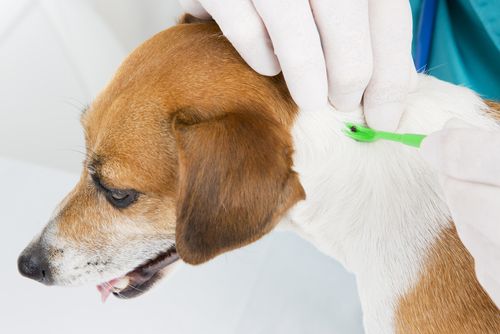
Heartworm is a serious illness that can cause heart failure, lung disease, organ damage and even death in dogs, cats and ferrets. Heartworm is most prevalent in pets living along the Atlantic Gulf coasts from New Jersey to the Gulf of Mexico as well as in those living alongside the Mississippi and its main tributaries. However, it has been found in pets in all states across America.
What causes Heartworm?
Heartworm is caused by parasitic worm larvae that live inside mosquitoes. When the mosquito bites an animal, it transfers some of the worm larvae into the animal where the larvae then mature, mate, and produce offspring inside its living host. The offspring produced by female adult heartworms is known as microfilariae, which lives in the host animals’ bloodstream. When a mosquito then bites an infected animal it draws microfilariae into its body where it turns it into infective larvae, beginning the cycle again.
Once an animal has been infected, it takes time for the larvae to mature into adults that are capable of reproduction. In dogs, this period is usually 6-7 months and in cats and ferrets is around 8 months. Adult heartworms look like cooked spaghetti and can range in size from 4-6 inches in males and 10-12 inches in females. The number of worms found in a pet is known as its ‘worm burden’ and can vary depending on the species of animal and the severity of the infection.
Heartworm in Dogs
The lifespan of heartworms within an infected dog is between 5 and 7 years with the average worm burden being 15. However, dogs have been seen with worm burdens ranging from 1 to 250.
Symptoms of Heartworm in Dogs
The severity of symptoms of heartworm in dogs is dependent on the worm burden of the animal, how long they have been infected, and how well their body can cope with the disease. However, it is usually broken down into four stages.
Class 1: No visible symptoms or very mild symptoms, such as an intermittent cough or wheeze.
Class 2: Mild to more moderate symptoms including intermittent coughing, lethargy or breathlessness after light to moderate exercise. At this time, some heart and lung changes may be seen on x-rays.
Class 3: Symptoms will include frequent or persistent coughing, lethargy, and breathlessness after mild activity. Heart and lung changes will definitely be visible on x-rays.
Class 4: This stage is otherwise known as Caval Syndrome and is reached when an infected animal has been left untreated for an extended period of time. At this stage, the animal experiences restricted blood flow to the heart caused by a blockage of worms. Heart failure is imminent and emergency surgery to remove the worms is the only course of action. However, this comes with its own risks and most dogs with Caval Syndrome do not survive.

Ticks are arachnids that belong to the same family as spiders and mites. They are parasitic and feed on the blood of host animals. Ticks are visible to the naked eye but are only about the size of a pinhead before swelling with blood as they feast.
Animals living in the Southern States or near heavily wooded areas will have increased exposure to ticks as they like to live in thick, long grass and will attach to host animals as they walk by. They are most active during the late spring and summer months and are not fussy about what species of animals they feed on. However, animals that spend a lot of time outdoors will be more susceptible to ticks.
Symptoms of Ticks
Animals with only a few ticks can present with little or no symptoms, which is why it is often not until there is a larger infestation or infection from the bites that signs become apparent. If and when symptoms do materialize, they can include itching, scratching and red or inflamed irritations on the skin.
Ticks can transmit a number of diseases including Babesia, Cytauxzoonosis, Lyme disease, and Mycoplasma. Some animals can also have allergic reactions to tick bites which can result in infections. Symptoms from these reactions or diseases can include fever, lethargy, loss of appetite and pain and can last for several days or even weeks. If you are concerned that your pet has developed an illness from a tick bite, consult with your veterinarian as soon as possible.

With thousands of unwanted dogs living in shelters and desperately looking for new homes, we highly recommend that you consider adopting one of these puppies or adult dogs. You will be able to find details of your local shelters and rescue centers online. However, if your heart is set on a purebred puppy then the very first thing you should do is find a reputable breeder.
Unfortunately, there are many people out there who view breeding purely as a source of income and have very little concern for either the current or future welfare of their puppies. However, by asking the right questions and making some careful observations, it is possible to distinguish between them and knowledgeable and professional breeders. Here is our guide to helping you find a reputable breeder for your future pet.

Letting children, particularly young children, and pets, especially new ones, play can be a little nerve-wracking. The main concern is for the safety of the child as it is more likely that an animal would physically hurt a child than the other way around. However, kids can injure pets too, and not just that, children can antagonize a pet to the point where the animal will act out.
This is mostly due to a couple of factors. First, children are still growing, learning, and testing boundaries, coupled with still learning how to verbalize their thoughts and needs. Second, pets can't verbalize at all, making it more difficult for them to communicate when they don't like something, want certain behaviors to stop, or are in pain. As a parent, you will need to step in and fill this fundamental gap in order for your child and your pet to be able to better understand each other.
Ensure new pets like kids
Keep in mind that some animals simply aren't comfortable around children, and that's okay. When adopting a new pet, especially if it's older, be sure to talk to the shelter or rescue organization staff to make sure the animal is safe to live with kids. Similarly, if you already have kids and kid-friendly pets, but are ready to adopt a new pet, make sure to ask if the animal is also comfortable with other animals. Bringing a new pet into a home where it's uncomfortable will only make them more stressed, and therefore more likely to hurt someone.

The addition of a new pet can be very exciting! However, knowing where to find your new companion and choosing the right one can be a daunting task. Here are some helpful tips to assist you in making your decision.
Things to keep in mind
Adopting a new pet is a big decision that shouldn’t be done impulsively. Pets require time, effort, and money to be cared for and loved just like any other member of the family. Do you have a yard large enough for a goat to live comfortably? Do you have time to walk your dog more than once a day, every day? Do you have enough money to regularly buy fresh litter for your cat?
Only consider adopting a new pet once you feel confident in your ability to care for them. This includes caring for your children’s pets. Children will naturally want to participate in all the fun aspects of pet care but may have trouble consistently remembering or wanting to do the dirty work. If you won’t be able to care for your pet when your kids can’t, your pet will be the one that’s left neglected.
But we understand that sometimes life can change! If you feel that you can no longer care for your pet, contact the shelter or organization you adopted the animal from, or feel free to come in and talk to us about potential options. There are plenty of choices if you need to rehome your pet so abandonment should never have to be one.

Despite how careful we try to be regarding toxic substances, there are still thousands of pets every year who unfortunately suffer from the accidental ingestion of harmful substances, many of which are household poisons. Poisoning can cause extreme health problems and even death, but these can be prevented by understanding which common household toxins may harm your pet and how to poison-proof your home. This guide will also explain some of the symptoms you should look out for and what you should do if you suspect your pet has ingested a toxic substance.
Most Common Poisons
We have taken information from the Pet Poison Helpline website to bring you information on some of the most common poisons for cats and dogs. Please be aware that these lists are in no specific order and the toxicity levels for these poisons are variable.
Top Ten most commonly reported cat poisons:
- Topical spot-on insecticides
- Household cleaners
- Antidepressants
- Lilies
- Insoluble oxalate plants
- Human and veterinary NSAIDS
- Cold and flu medication (e.g. Tylenol)
- Glow sticks
- ADHD/ADD medications and amphetamines
- Mouse and rat poison
Top Ten most commonly reported dog poisons:
- Chocolate
- Mouse and rat poisons
- Vitamins and minerals
- NSAIDS
- Cardiac medications
- Cold and allergy medications
- Antidepressants
- Xylitol
- Acetaminophen
- Caffeine pills
Plants that are poisonous to pets
Although there are thousands of species of plants, there are a few that are highly toxic to pets.
This list represents some of the most poisonous plants to pets.
- Autumn Crocus
- Azalea
- Cyclamen
- Kalanchoe
- Lilies
- Oleander
- Dieffenbachia
- Daffodils
- Lily of the Valley
- Sago Palm
- Tulips
- Hyacinths

Being a beloved part of our family means that our pets sometimes travel with us when we go on long journeys. As a general rule, cats typically dislike traveling and are almost always better off staying at home in their own environment. On the other hand, dogs are generally more amenable to traveling, but there are still a number of considerations to make to ensure that the journey is both safe and comfortable for your pet.
Traveling by Car
The most important thing to remember when traveling by car is to ensure that your pet is not free to roam around the vehicle. Not only could this be distracting for the driver, but your pet will not be protected in the event of a crash. You may have seen dog seat belts being sold in some pet stores and whilst they have been approved for sale, there is no reliable evidence proving them to be effective in accidents. Instead, you should secure your pet in a crate that is big enough for your pet to change position if they become uncomfortable and that has been tethered to the car by a seatbelt or other secure method.
Do not put animals in the front passenger seat of your vehicle. If the airbag deploys, there is a chance that your pet could be seriously injured.
Do not ever leave your pet alone in the car. Animal thieves frequent parking lots and service stations, looking for unattended pets to steal. Also, leaving an animal alone in a warm car can be fatal. On a day where the outside temperature is 85F, the temperature inside your vehicle can reach 120F in just 10 minutes, putting your pet at serious risk.
Do not allow your pet to stick his head outside a moving vehicle. Doing so risks injury or sickness by fast-moving air forcing itself into your pet's lungs.
Never transport your pet in the back of an open pick-up truck.
Make plenty of bathroom breaks. This will also allow your pet to stretch their legs and have a drink.
As a general rule, if you wouldn’t allow your child to do it, do not allow your pet to do it either!

Not everyone is lucky enough to live in a state with relatively consistent weather and temperatures and just as humans change their behavior and diet with fluctuations in temperature, so do most animals. Here are our guidelines for seasonal care for your pets.
Winter
- If your pet usually likes to spend most of its time outdoors, be sure to bring them inside as the temperatures in your area begin to fall. If circumstances mean that your pet has to be kept outdoors, make sure that they are as warm and comfortable as possible by providing them with a dry and draft-free shelter with plenty of extra blankets. You should also regularly check their water supply to ensure that it hasn’t frozen.
- If the ground is covered with snow, ice or is extremely cold, you may want to consider purchasing animal booties which are widely available from most pet stores.
- Be prepared to see a change in your pet's eating habits as well. Outdoor pets tend to require extra food since they will burn extra food to help keep them warm. While indoor pets are likely to eat far less as they conserve energy by sleeping more.
- Be sure to keep your pets away from antifreeze. Unfortunately, while it smells and tastes delicious to cats and dogs, even the smallest sip can be deadly. Keep pets out of garages and outbuildings and clean up any spillages as soon as they happen. Speak to your neighbors about the dangers of antifreeze ingestion and ask them to ensure that any antifreeze they have is securely stored and that they too clean up any spillages that may occur. If your pet acts as if they are drunk or begins to convulse, take them to a vet immediately.
- Check under the hood of your car before starting the engine. Many cats like to sneak under the hood of a vehicle once you have gone inside to keep warm by the engine. If you are unable to open the hood, then a firm tap on it should be sufficient to wake any sleeping cat.
- Ensure that rabbit hutches are brought inside. If this isn’t possible, put extra newspapers in the hutch for better insulation. Again, check their water source regularly to ensure that it isn’t frozen.

It turns out that the benefits of owning a pet include more than just adorable cuddles and trips to the dog park. Owning a pet can also improve your overall health and wellness.
On a psychological level, pets are shown to decrease levels of depression and anxiety. And for overall health, owning a pet can decrease your blood pressure, increase your immune system, make you less likely to suffer from a heart attack or stroke, and more.
1. Get a Pet & Get Rid of Stress
A study in 2002 by the State University of New York at Buffalo found that having your pet around during difficult tasks helped to decrease stress. They found that having pets around helped participants stay calm and focused on the task at hand and were even more beneficial than having a close friend or family member nearby.
Promises Treatment Centers, which helps recovering drug addicts, allows pets into their rehab facilities. The CEO of the facility believes that having your pet around makes the recovery process less stressful, making drug addicts less likely to reach for unhealthy or dangerous substances as a way to decompress.
So, the next time you’re going through a tough time at home or work, try taking a breather and hang out with your pets.
2. Own a Pet & Lower Your Blood Pressure
A study by the CDC suggests that having a dog can lower blood pressure, especially for high-risk hypertensive patients. High blood pressure is often caused by stress and when life throws you stressful curveballs, having a dog (or cat) that loves you unconditionally can help you feel at ease. It’s also thought that owning a pet gives you more opportunities to go outside and exercise, which strengthens your heart and lowers your blood pressure that way.
3. Raise a Pet and Lower Your Cholesterol
The CDC suggests that another healthy component of owning a pet is lowering your cholesterol. Research has found that people who own pets (particularly men) have lower levels of cholesterol and triglycerides than those without pets. Who needs Cheerios, when you can get a dog! Like lower blood pressure, it’s not known if the pet’s presence is specifically lowering cholesterol, or if it’s caused by the lifestyle that comes with owning a pet.

Also known as CDV, Canine Distemper is a highly contagious viral illness that can be debilitating and even fatal. It not only affects dogs, but can also be seen in certain species of wildlife, including foxes, skunks, and wolves. Puppies and non-immunized dogs are most commonly affected, but pets on immune-suppressing medications may also be vulnerable.
CDV is resistant to the majority of cleaning products, and household bleach is the only known way to eradicate it.
What causes CDV?
The CDV virus is mainly transmitted through direct contact with an infected animal via bodily fluids such as saliva from coughs or sneezes which is why inhalation is the most common way it enters a new dog's system. CDV attacks the respiratory system, gastrointestinal tract, and central nervous system.
The virus does not live long once outside the body, so indirect contact is extremely rare.
As with most contagious diseases, animal shelters and kennels are much more likely to be contaminated.
Symptoms of CDV
The primary symptoms of CDV include, but are not limited to:
Coughing
Diarrhea
Fever
Lethargy
Nasal discharge
Reduced appetite
Vomiting
Watery or pus-like discharge from the eyes
Once the virus reaches the central nervous system (CNS), it can cause twitching, seizures, and partial or total paralysis. This causes irreparable damage to a dog’s nervous system, often resulting in death.










